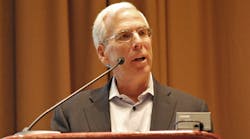“The 2.6 billion cell phones in the world are always on, and that is trickling down into the supply chain causing an explosion of online orders." Deloitte’s Scott Sopher discussed the many challenges—and emerging solutions—in the business of moving things from point A to point B.
The material-handling industry is evolving to move more products from Point A to Point B at the click of a button. There will be many technology-driven developments and challenges in this industry, and there are several trends driving them right now.Today, retailers are using automation technology in their front and back offices to deliver digital transformation, decreasing costs and increasing operational efficiencies. During the Material Handling Industry Forum at Automation Fair this week in Philadelphia, leading retailers and subject matter experts discussed current and future industry trends, implementation of new technologies and using automation to improve consumer engagement.
Scott Sopher, principal at Deloitte Consulting, discussed developments that are expected to occur over the next three to five years. "Deloitte has been working with the Material Handling Industry of America (MHI.org) for the past six years, generating an annual report on ‘next-gen’ solutions in the supply chain space, including logistics and material handling," said Sopher. "At the start there was little adoption of cutting-edge solutions, but it's amazing what has happened over the past six years."
"The digital supply chain revolution is here," said Sopher. "The digital world is exploding and is having a major impact on our supply chains. It's on demand and always on. The customer expectations—the last mile—is more demanding now, with higher customer service and shorter cycle times required. The 2.6 billion cell phones in the world are always on, and that is trickling down into the supply chain causing an explosion of online orders."
This puts demands on the supply chains that are probably higher than ever. "There is a more integrated need for fulfillment," said Sopher. "Historically, supply chain organizations were very siloed, with procurement, warehousing, customer service, and transportation as separate but collaborating functions. But now the organization needs to have the functions integrated across the chain as a network. It's driving dramatic changes in our material handling industry."
And the survey says…
The data that came out of the 2018 MHI Annual Industry Report was pretty revealing. "The report surveyed 1,100 people in the supply chain industry, many at the CEO level and from large companies," said Sopher.
"Out of a list of 11 innovations, cloud computing and storage had the highest predicted adoption rate with over 90% expected within five years. Sensors and automatic identification was number two, and inventory and network optimization was third on the list. “What's interesting is, if you look at the first six or seven innovations, the survey suggests that all will be at 90% adoption within five years."
Several key innovations are driving next-gen supply chains. "Robotics and automation is the number one innovation that could potentially disrupt and provide competitive advantage," said Sopher. "Big data and predictive analytics was rated the number two technology offering disruption and opportunity. The Internet of Things (IoT) and sensors was third, followed by artificial intelligence and then driverless vehicles/drones."
Meanwhile, the top supply chain challenge identified is that of customer demands, with a shortage of qualified workers close behind. These have been consistent theme over the past five years, Sopher said.
"Another survey question was related to cybersecurity risks to the organization and supply chain," said Sopher. "First, 44% were worried about the increasing sophistication of hackers, and, second, 40% were worried about lack of awareness within their own organizations. A third concern among 37% of respondents is lack of proper cybersecurity practices amongst their suppliers. This will be a greater focus of companies as supply chains become even more interconnected."
Wearables are another key innovation for next-gen supply chains, and can save a company money while improving productivity. "At a recent Logistics CIO Forum, a leading third-part logistic company discussed a pilot it did with wearables, similar to [Google] Glass, in the picking area," said Sopher. "They saw an 8% improvement in productivity. More importantly, they found that their turnover in that area decreased dramatically, saving training costs, as well as the ramp up it takes for new employees to get to the productivity levels expected."
The editors of Control are on-site at Automation Fair 2018 to bring you breaking news, innovations and insights from the event. Once the event is over, they will put together a report featuring the top news. Pre-order your copy today.






